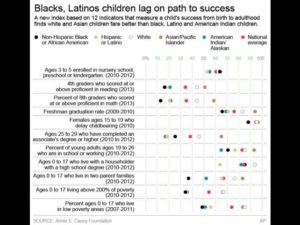A new report by the Annie E. Casey Foundation revealed that Black children in the U.S. face more disadvantages than any other race.
The study marked a dozen different milestones in the stages of life and compared how each racial group fared against the rest.
For African-American children, the pattern of disadvantage started on the very first milestone – birth.
According to the report, the racial gaps start out small but only grow as time goes on.
At birth, more than 90 percent of white, Latino, American-Indian and Asian and Pacific Islander babies are born at a normal weight. For African-American children this percentage is in the upper 80s.
By the time children reach high school, the gap in graduation rates widens to almost 30 percent.
A little more than 60 percent of African-American children graduate high school on time, while more than 90 percent of Asian-Americans and Pacific Islanders do.
The study also looks at family income, educational levels, neighborhood poverty levels, employment prospects and several other factor to create a composite score for the children that ranges from one to 1,000.
Asian children had the highest composite score of 776. White children weren’t far behind with a score of 704.
Unfortunately, the gap widens dramatically after that point.
“Scores for Latino, American-Indian and African-American children are distressingly lower, and this pattern holds true in nearly every state,” the report said.

According to the Casey Foundation’s president, Patrick McCarthy, results of the research are “a call to action that requires serious and sustained attention from the private, nonprofit, philanthropic and government sectors to create equitable opportunities for children of color.”
The report also described the low score of African-American children as “a national crisis.”
The report made several suggestions as to how such a serious issues can be resolved, including expanding job opportunities to the youth in the disadvantaged groups and collecting more race-specific data to help pinpoint the cause of such disparities.
In the conclusion of the report, a plea is made for all Americans to pay attention to the troubling findings.
“Regardless of our own racial background or socio-economic position, we are inextricably interconnected as a society,” the report said. “We must view all children in America as our own – and as key contributors to our nation’s future.”



